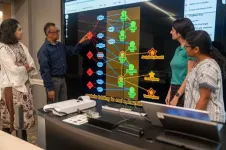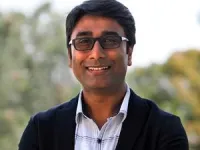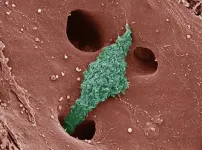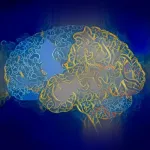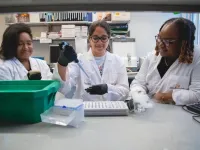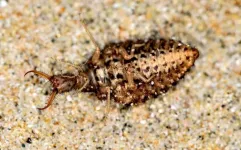(Press-News.org) Viruses like SARS-CoV-2 don’t respect boundaries, moving between species and continents and leaving destruction as they go. Beating the next pathogen with pandemic potential means getting good at crossing borders ourselves — between fields of study, between research universities, and between scientists and the wider community.
An $18 million grant announced by the U.S. National Science Foundation (NSF) will put that goal within reach. The award brings together five universities and more than 20 researchers, academics, and public health experts to establish the Virginia Tech-led Center for Community Empowering Pandemic Prediction and Prevention from Atoms to Societies (COMPASS).
Headquartered in the university’s interdisciplinary Data and Decision Sciences Building, the center’s collaborators will have access to high-tech labs, data centers, and other facilities. But the work won’t be confined to the buildings or even the borders of Virginia Tech.
Cornell University, the University of Michigan, Meharry Medical College, and Wake Forest University also will collaborate to meet the critical challenge of thwarting infectious diseases that threaten the global community. T.M. Murali, associate department head for research in the Department of Computer Science will direct the new center.
The COMPASS Center is part of an overall $72 million NSF Predictive Intelligence for Pandemic Prevention program established to better understand how pathogens and diseases emerge and spread as well as to train the next generation of scientists to carry on the work to stop them. The project was supported by two rounds of funding from the Office of the Executive Vice President and Provost that established a Virginia Tech research thrust for pandemic prediction and prevention.
“This NSF award exemplifies what can be achieved by convening an interdisciplinary team of faculty committed to advancing an area of particular strength at Virginia Tech – the development of predictive models and approaches necessary for management of infectious diseases that so often arise from the inextricable linkages between humans, animals, and the environment,” said Executive Vice President and Provost Cyril Clarke. “Pandemic prediction and prevention is an area of scholarly emphasis selected for prioritized investment through our transdisciplinary Destination Area program.”
At a glance
The $18 million Virginia Tech led COMPASS Center will
Bring together researchers and academics from many disciplines and rally them to one focus: understanding how a virus infects its host and what it does in the body
Include researchers from Cornell University, the University of Michigan, Meharry Medical College, and Wake Forest University
Focus on talking with, and more importantly, listening to the needs and concerns of the public
Inspire and train the next generation of scientists to further pandemic science and better connect with non-scientists about it
The interdisciplinary COMPASS Center established under an $18 million National Science Foundation grant includes more than 20 collaborators across five institutions. Some of the Virginia Tech researchers and staff involved are: (top row, from left) Padma Rajagopalan, X.J. Meng, Patricia Raun, Lisa Lee, and T.M. Murali and (bottom row, from left) Leslie Thornton-O’Brien, Kylene Kehn-Hall, and Anuj Karpatne. Photo by Tonia Moxley for Virginia Tech.
The majority of emerging human viruses originate from wildlife and domestic animal species. “There are many challenges in trying to determine if a virus that currently infects one or more animals can jump to humans, and when that leap can lead to a pandemic,” Murali said.
The center will focus on answering four key questions:
How does a pathogen, like a virus, jump from one species to another? Researchers will use predictive models based on machine learning to find out how changes in a pathogen may enable it to infect new species.
How does a pathogen replicate inside a host? The research group will develop new ways to create organoids — miniaturized models of organs that mimic their key functions — to grow a new virus, study its life cycle, and test new and existing drugs and therapies on it.
What are the factors that permit a pathogen to persist in the environment? The goal of the researchers is to develop approaches that can identify the features of a pathogen or the environment that can cause inactivation.
How do we empower the public with the scientific knowledge gained through this work? Faculty and students involved in COMPASS will be trained to better communicate with the public around pandemic science, and the researchers will meet with the public in community dialogues.
“What we are focusing on is really trying to understand how a pathogen or a virus can shift to a new host and how it interacts with a host at a cellular, organ, or the whole body,” Murali said. “Essentially, we want to discover the rules of life that govern these interactions and use that information to make the world safer.”
In the collaborators’ words
To achieve the ambitious goal of understanding and predicting how pathogens interact with hosts, collaborators will work in four crucial areas.
Jumping the species barrier
X.J. Meng, University Distinguished Professor of Molecular Virology at the Virginia-Maryland College of Veterinary Medicine, studies emerging and zoonotic viruses of veterinary and human public health significance and develops life-saving vaccines.
“With colleagues at Cornell University and the University of Michigan, we will attempt to predict, through novel machine learning systems, which viruses will jump from animals to humans, and which specific mutations within the viral genome may enable these shifts. We will also experimentally validate the computational predictions through biological studies using human organoid cultures,” Meng said. “Successful identification of genetic elements responsible for virus species jumping and adaptation will help design better prevention and control strategies against emerging viruses.”
Replicating inside a host
Padma Rajagopalan, Robert E. Hord Jr Professor in the Department of Chemical Engineering, and collaborators at the Wake Forest Medical School will bring their expertise in liver and other tissues and organs to the collaboration. While viruses and other pathogens are the subject of much study, it can be very difficult to grow them in the lab. Organoids could be the key to unlocking a deeper understanding of the life cycle of an emerging virus and ways to counteract it.
“We believe that 3D multicellular tissue organoids — miniature tissue models that mimic key functions of an organ -- can be used to understand how viruses enter, propagate, and potentially cause damage to different organs either individually or when integrated together,” Rajagopalan said. “On the other side of the equation, engineers, biologists and virologists can work together to test drugs that could be used against the virus and any complications it causes.”
Persisting in the environment
University Distinguished Professor Linsey Marr in the Charles Edward Via, Jr. Department of Civil and Environmental Engineering and collaborators at the University of Michigan will seek to discover what helps emerging pathogens grow and survive and what conditions can arrest their spread.
“How long a virus survives, or persists, in the environment is one key factor in its ability to spread rapidly. If SARS-CoV-2 didn't survive long in respiratory droplets, we would not have had a pandemic,” Marr said. “COMPASS will help us be able to predict whether new threats, such as the H5N1 flu virus in cows, can survive for a long time in milk, or whether it would quickly die off under certain conditions.”
Empowering scientists and the public
In 2016, Alumni Distinguished Professor of Theatre Arts Patricia Raun helped found the university’s Center for Communicating Science, which she now directs. Based on a concept developed by actor and science enthusiast Alan Alda, the center uses the tools of the arts, including embodied learning, deep listening, improvisation, role play, and storytelling to train and educate everyone about science.
Raun and her staff will work with COMPASS faculty and students to teach them new ways to both talk with and listen to the public. Students receiving this training will include summer interns recruited by collaborators at Meharry Medical College.
“I believe it’s going to take all of us to solve the world's challenging problems,” Raun said. “My part of that is around helping scientists and people in highly technical fields connect with the public and communicate with us in ways we can understand.”
The Virginia Tech faculty collaborating within the COMPASS Center include
T. M. Murali, principal investigator and center director
Julie Gerdes, assistant professor of technical and professional writing and rhetoric, College of Liberal Arts and Human Sciences
Anuj Karpatne, associate professor of computer science, College of Engineering and core faculty at the Sanghani Center for Artificial Intelligence and Data Analytics
Kylene Kehn-Hall, professor of virology in the Virginia-Maryland College of Veterinary Medicine and director of the Center for Emerging, Zoonotic, and Arthropod-borne Pathogens
Lisa M. Lee, interim senior associate vice president for research and innovation and director in the Division of Scholarly Integrity and Research Compliance
Linsey Marr, University Distinguished Professor and Charles P. Lunsford Professor of Civil and Environmental Engineering
X.J. Meng, University Distinguished Professor of Molecular Virology, Virginia-Maryland College of Veterinary Medicine and professor of internal medicine at the Virginia Tech Carilion School of Medicine
Padma Rajagopalan, Robert E. Hord Jr Professor of Chemical Engineering and program director of the Computational Tissue Engineering Interdisciplinary Graduate Education Program
Naren Ramakrishnan, Thomas L. Phillips Professor of Engineering and director of the Sanghani Center for Artificial Intelligence and Data Analytics
Patricia Raun, Alumni Distinguished Professor of Theatre Arts and director of the Virginia Tech Center for Communicating Science
Next steps
One of the first events that the COMPASS Center will organize is a National Dialogue on the Ethics of Pandemic Research in Washington D.C. in November. The goal of the event is to incorporate community voices and feedback into research in pandemic science. Researchers and community-based partners will collaboratively identify key ethical questions that arise in pandemic science.
The center will collaborate on diverse research projects with industry, federal agencies, and international organizations. Murali expects these efforts to result in a robust public-private ecosystem to provide solutions to diverse problems in pandemic science.
END
Building a COMPASS to navigate future pandemics
An $18 million U.S. National Science Foundation grant will establish a new Virginia Tech center to bring computer science, infectious disease, engineering, and the arts together to predict and prevent global pandemics
2024-08-22
ELSE PRESS RELEASES FROM THIS DATE:
Macrophage mix helps determine rate and fate of fatty liver disease
2024-08-22
Formerly known as nonalcoholic steatohepatitis, metabolic dysfunction-associated steatohepatitis (MASH) is an inflammatory disease characterized by liver scarring or fibrosis that progressively impairs liver function.
It is a major risk factor for cirrhosis and liver cancer. And because treatment options are limited, MASH is the second leading cause for liver transplants in the United States after cirrhosis caused by chronic hepatitis C infection.
A better understanding of the pathological processes that drive MASH is critical to creating effective treatments. In a new paper published ...
Department of Energy announces $36 million to support energy-relevant research in underrepresented regions of America
2024-08-22
WASHINGTON, D.C. - Ensuring that scientific funding goes to states and territories that have typically received smaller fractions of federal research dollars in the past, the Department of Energy (DOE) today announced $36 million in funding for 39 research projects in 19 states via the Established Program to Stimulate Competitive Research (EPSCoR). The grants connect innovative ideas from scientists at eligible institutions with leading-edge capabilities at the DOE national laboratories.
Supporting scientists while building the expertise and capabilities critical for performing leading research ...
Analysis of 1,500 climate policies reveals only a small fraction achieved significant emission reductions
2024-08-22
A new machine learning analysis has revealed the most effective climate policies out of 1,500 implemented worldwide over the last two decades. Some of the success stories – numbered at about 63 – involve rarely studied policies and unappreciated policy combinations. “Our results provide a clear yet sobering perspective on the policy effort necessary for closing the remaining emissions gap of 23 billion tons carbon dioxide (CO2) by 2023,” write the authors. To achieve the Paris Agreement’s climate targets, it is essential to know which ...
Fatty-acid derived polymers yield recyclable and highly versatile adhesives
2024-08-22
Researchers have presented a new family of polymer adhesives that offer a sustainable and recyclable alternative to conventional polymer adhesives and can be used across a wide range of applications, from industrial adhesives to surgical superglues. The new chemical approach to aLA polymerization addresses the performance and environmental challenges of traditional polymers, providing environmentally friendly adhesive solutions. Polymer adhesives are ubiquitous in modern life and are widely used in many medical, consumer, and industrial products. Given this diversity, each adhesive material is often tailored ...
Governance needed to ensure biosecurity of biological AI models
2024-08-22
Concerns over the biosecurity risks posed by artificial intelligence (AI) models in biology continue to grow. Amid this concern, Doni Bloomfield and colleagues argue, in a Policy Forum, for improved governance and pre-release safety evaluations of new models in order to mitigate potential threats. “We propose that national governments, including the United States, pass legislation and set mandatory rules that will prevent advanced biological models from substantially contributing to large-scale dangers, such as the creation of novel or enhanced pathogens ...
Spontaneous transfer of mitochondrial DNA into the nuclear genomes in the human brain over the individual’s lifespan
2024-08-22
Somatic nuclear mitochondrial DNA (Numt) insertions are mito-nuclear gene transfer events that can arise in the germline and in cancer. This study shows that Numt insertions arise spontaneously and accumulate in brain tissues during development or over the human lifespan.
#####
In your coverage, please use this URL to provide access to the freely available paper in PLOS Biology: http://journals.plos.org/plosbiology/article?id=10.1371/journal.pbio.3002723
Article Title: Somatic nuclear mitochondrial DNA insertions are prevalent in the human brain and accumulate over time in fibroblasts
Author Countries: United States
Funding: see manuscript END ...
Cancer drug could treat early-stage Alzheimer’s disease, study shows
2024-08-22
UNIVERSITY PARK, Pa. — A type of drug developed for treating cancer holds promise as a new treatment for neurodegenerative diseases such as Alzheimer’s, according to a recent study by researchers at Penn State, Stanford University and an international team of collaborators.
The researchers discovered that by blocking a specific enzyme called indoleamine-2,3-dioxygenase 1, or IDO1 for short, they could rescue memory and brain function in models that mimic Alzheimer’s disease. The findings, published today (Aug. 22) in the journal Science, suggest that IDO1 inhibitors currently ...
Drugs that improve brain metabolism could help Alzheimer’s patients
2024-08-22
Among the many ways neuroscientists think Alzheimer’s disease may strip away brain function is by disrupting the glucose metabolism needed to fuel the healthy brain. In essence, declining metabolism robs the brain of energy, impairing thinking and memory.
Against that backdrop, a team of neuroscientists at the Knight Initiative for Brain Resilience at Stanford’s Wu Tsai Neurosciences Institute have zeroed in on a critical regulator of brain metabolism known as the kynurenine pathway. They hypothesize that that the kynurenine pathway is overactivated as a result of ...
Life after (feigned) death
2024-08-22
A new study led by scientists from the University of Bristol has revealed what animals do after they have feigned death in order to avoid being killed by a predator and what the context of this behaviour is.
Many animals, as a last-ditch defence, become motionless after being contacted by a predator.
This behaviour is so common that it's recognised in such phrases as “playing possum”. It is even said to occur in humans in extreme circumstances.
In previous studies, carried out by the same team using antlion larvae, scientists noticed that they become motionless after being individually handled.
At one point ...
Fisheries research overestimates fish stocks
2024-08-22
Many fish stocks around the world are either threatened by overfishing or have already collapsed. One of the main reasons for this devastating trend is that policymakers have often ignored the catch limits calculated by scientists, which were intended to be strict thresholds to protect stocks. But it has now become clear that even these scientific recommendations were often too high.
In the European Union (EU), for example, fisheries are primarily managed through allowable catch limits, known as quotas, which are set by the European ...
LAST 30 PRESS RELEASES:
The vast majority of US rivers lack any protections from human activities, new research finds
Ultrasound-responsive in situ antigen "nanocatchers" open a new paradigm for personalized tumor immunotherapy
Environmental “superbugs” in our rivers and soils: new one health review warns of growing antimicrobial resistance crisis
Triple threat in greenhouse farming: how heavy metals, microplastics, and antibiotic resistance genes unite to challenge sustainable food production
Earthworms turn manure into a powerful tool against antibiotic resistance
AI turns water into an early warning network for hidden biological pollutants
Hidden hotspots on “green” plastics: biodegradable and conventional plastics shape very different antibiotic resistance risks in river microbiomes
Engineered biochar enzyme system clears toxic phenolic acids and restores pepper seed germination in continuous cropping soils
Retail therapy fail? Online shopping linked to stress, says study
How well-meaning allies can increase stress for marginalized people
Commercially viable biomanufacturing: designer yeast turns sugar into lucrative chemical 3-HP
Control valve discovered in gut’s plumbing system
George Mason University leads phase 2 clinical trial for pill to help maintain weight loss after GLP-1s
Hop to it: research from Shedd Aquarium tracks conch movement to set new conservation guidance
Weight loss drugs and bariatric surgery improve the body’s fat ‘balance:’ study
The Age of Fishes began with mass death
TB harnesses part of immune defense system to cause infection
Important new source of oxidation in the atmosphere found
A tug-of-war explains a decades-old question about how bacteria swim
Strengthened immune defense against cancer
Engineering the development of the pancreas
The Journal of Nuclear Medicine ahead-of-print tip sheet: Jan. 9, 2026
Mount Sinai researchers help create largest immune cell atlas of bone marrow in multiple myeloma patients
Why it is so hard to get started on an unpleasant task: Scientists identify a “motivation brake”
Body composition changes after bariatric surgery or treatment with GLP-1 receptor agonists
Targeted regulation of abortion providers laws and pregnancies conceived through fertility treatment
Press registration is now open for the 2026 ACMG Annual Clinical Genetics Meeting
Understanding sex-based differences and the role of bone morphogenetic protein signaling in Alzheimer’s disease
Breakthrough in thin-film electrolytes pushes solid oxide fuel cells forward
Clues from the past reveal the West Antarctic Ice Sheet’s vulnerability to warming
[Press-News.org] Building a COMPASS to navigate future pandemicsAn $18 million U.S. National Science Foundation grant will establish a new Virginia Tech center to bring computer science, infectious disease, engineering, and the arts together to predict and prevent global pandemics
